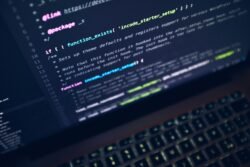In a world increasingly dominated by artificial intelligence, the White House Office of Science and Technology Policy (OSTP) has developed a groundbreaking Blueprint for an AI Bill of Rights. This innovative initiative aims to safeguard the rights of the American public by ensuring that the use of technology and automated systems aligns with democratic values. Guided by five crucial principles, including safe and effective systems, algorithmic discrimination protections, data privacy, notice and explanation, and the inclusion of human alternatives, the Blueprint tackles pressing issues such as biased automated systems, algorithmic discrimination, privacy violations, lack of transparency, and the need for human involvement. With valuable insights and input from various stakeholders, the Blueprint is supported by a comprehensive handbook called “From Principles to Practice” that offers practical guidance for implementing these protections in both policy and everyday practice. Ultimately, the OSTP’s goal is to harness the power of technology and AI advancements for the greater good, while ensuring that civil rights and democratic values remain unyielding.
Guiding Principles
The Blueprint for an AI Bill of Rights is based on five guiding principles that are essential in protecting the rights of individuals in the age of artificial intelligence. These guiding principles provide the foundation for the development of policies and regulations that promote safe and ethically sound AI systems.
Safe and Effective Systems
One of the primary goals of the AI Bill of Rights is to ensure that AI systems are safe and effective. This means that these systems should be designed and implemented in a way that minimizes risks and maximizes their potential benefits. Safety standards and regulations must be established to ensure that AI systems are held to a high level of accountability.
Algorithmic Discrimination Protections
It is crucial to address the issue of algorithmic discrimination in AI systems. Algorithms can inadvertently perpetuate biases and discrimination, leading to unfair outcomes. The Blueprint aims to identify and address bias in algorithms to promote fairness and equity. It also entails implementing measures that prevent discrimination and holding accountable those responsible for any discriminatory practices.
Data Privacy
Protecting the privacy of individuals is of utmost importance in the age of AI. The Blueprint emphasizes the need for transparency in data collection and use. Users should have clear knowledge of how their data is being collected and used by AI systems. Informed consent and opt-out mechanisms should be in place to give individuals control over their personal information. Additionally, strong measures for data minimization and anonymization, as well as secure storage and transmission, must be implemented to safeguard user privacy.
Notice and Explanation
AI systems often make decisions and take actions with little to no explanation. This lack of transparency can lead to distrust and misunderstanding. The AI Bill of Rights seeks to address this issue by advocating for clear notice to users regarding the capabilities and limitations of AI systems. Moreover, explanations for AI systems’ decisions and actions need to be provided in a manner that is accessible to non-technical users. By doing so, potential harm or discrimination can be adequately addressed.
Human Alternatives, Consideration, and Fallback
While AI systems have the potential to enhance decision-making processes, human oversight and intervention are still crucial. The Blueprint emphasizes the need for maintaining human decision-making authority and ensuring human alternatives are considered in situations where AI may fall short. Ethical and social implications should be taken into account to prevent any unintended negative consequences. Establishing fallback plans and redundancies is essential to ensure that reliance on AI systems does not leave individuals without recourse.
Issues to Address
The Blueprint for an AI Bill of Rights aims to address several pressing issues that have arisen in the age of artificial intelligence. By identifying and tackling these issues, the rights of individuals can be better protected and balanced with technological advancements.
Unsafe and Biased Automated Systems
The rapid proliferation of automated systems poses risks to individuals’ safety. Errors or flaws in AI systems can lead to significant harm, making it essential to establish standards and regulations to minimize these risks. Additionally, biases in algorithms can perpetuate inequalities and discrimination. The AI Bill of Rights aims to ensure that AI systems are free from bias and work towards fair outcomes.
Algorithmic Discrimination
The use of algorithms can inadvertently perpetuate discrimination and biases, leading to unequal treatment of individuals or groups. This can have far-reaching consequences in areas such as employment, criminal justice, and access to resources. The AI Bill of Rights aims to identify and address bias in algorithms to foster fairness and equity in AI systems.
Privacy Violations
The rise of AI systems has raised concerns about the privacy of individuals’ personal information. AI often relies on vast amounts of data, and the misuse or unauthorized access to this data can lead to privacy violations. The AI Bill of Rights emphasizes the need for transparency, informed consent, and robust security measures to protect individuals’ data privacy.
Lack of Transparency
AI systems often make decisions and take actions without providing transparent explanations for their reasoning. This lack of transparency can lead to distrust and misunderstanding. The AI Bill of Rights seeks to address this issue by advocating for clear notice to users and accessible explanations for non-technical users. By doing so, individuals can better understand and trust the decisions made by AI systems.
Need for Human Alternatives
While AI can enhance decision-making processes, it should not replace human judgment entirely. Human oversight and intervention are crucial to prevent potential errors or biases in AI systems. The AI Bill of Rights emphasizes the importance of maintaining human decision-making authority and considering ethical and social implications when implementing AI systems. Fallback plans and redundancies should be established to ensure that individuals are not left without recourse when AI systems fall short.

Development of the Blueprint
The development of the Blueprint for an AI Bill of Rights involved input from various stakeholders, including experts in the field of AI, policymakers, and representatives from civil society. The goal was to gather a wide range of perspectives to ensure that the blueprint represents the interests and concerns of the American public.
Various consultations, workshops, and meetings were conducted to gather input and insights from these stakeholders. These discussions revolved around the guiding principles of the Blueprint and the specific issues it aimed to address. Feedback and suggestions were carefully considered in the development of the AI Bill of Rights.
To support the implementation of the Blueprint, a handbook titled “From Principles to Practice” was created. This handbook offers practical guidance on how to incorporate the principles outlined in the AI Bill of Rights into policy and practice. It provides concrete steps and recommendations to ensure that the protections afforded by the Blueprint are effectively realized.
Objective of the Blueprint
The overarching objective of the Blueprint for an AI Bill of Rights is to ensure that technology and AI advancements benefit society while preserving civil rights and democratic values. By addressing the issues outlined earlier, the Blueprint aims to create a framework that promotes responsible and ethical use of AI systems.
Ensuring Technology Benefits Society
Technology has the potential to improve the lives of individuals and shape society for the better. The AI Bill of Rights aims to harness the potential of AI systems to benefit society by ensuring their safety, fairness, and accountability. By establishing guidelines and regulations, the Blueprint ensures that AI systems are developed and deployed in a manner that maximizes positive impacts and minimizes potential risks.
Preserving Civil Rights
In the age of AI, there is a growing concern about the potential infringement on civil rights. The AI Bill of Rights seeks to protect individual rights and prevent discrimination, bias, and privacy violations. By establishing clear guidelines and accountability measures, the Blueprint ensures that AI systems operate within the boundaries of civil rights laws and regulations.
Protecting Democratic Values
As AI becomes increasingly embedded in various aspects of society, it is essential to protect democratic values such as transparency, fairness, and accountability. The AI Bill of Rights aims to achieve this by advocating for clear notice and explanations, ensuring human oversight, and addressing potential harm or discrimination. By doing so, the Blueprint ensures that AI systems align with democratic principles and uphold the values that underpin a just and equitable society.

Section 1: Safe and Effective Systems
Definition of Safe and Effective Systems
The AI Bill of Rights defines safe and effective systems as AI technologies that have undergone rigorous testing and certification processes to ensure they meet established safety standards. These systems are designed to function reliably and accurately, minimizing the risks associated with their use. The Blueprint emphasizes that safety and effectiveness should be an inherent part of AI development from the early stages to deployment and ongoing evaluation.
Establishing Standards and Regulations
To ensure safe and effective systems, the AI Bill of Rights calls for the establishment of standards and regulations that govern the development and use of AI technologies. These standards should cover areas such as system reliability, accuracy, and robustness. By setting clear expectations, the Blueprint aims to create a framework that promotes accountability and responsible AI development.
Testing and Certification Processes
The AI Bill of Rights emphasizes the importance of testing and certification processes to assess the safety and reliability of AI systems. These processes should include comprehensive evaluations of AI systems to identify and mitigate potential risks. The Blueprint encourages the establishment of independent certification bodies to ensure the impartiality and integrity of the certification process.
Ongoing Evaluation and Improvement
The AI Bill of Rights recognizes that AI systems should not be treated as static entities but need to be continuously evaluated and improved. The Blueprint calls for mechanisms to monitor and evaluate the performance and impact of AI systems throughout their lifecycle. This ongoing evaluation process allows for the identification and rectification of any issues that may arise, ensuring that AI systems remain safe and effective.
Section 2: Algorithmic Discrimination Protections
Identifying and Addressing Bias in Algorithms
The AI Bill of Rights acknowledges that algorithmic bias can perpetuate discrimination and inequalities. To address this, the Blueprint emphasizes the need to identify and mitigate bias in algorithms. Developers should undergo comprehensive training on how to identify and address bias in AI systems. Additionally, tools and methodologies should be developed to continually monitor and detect bias in algorithms.
Ensuring Fairness and Equity
The AI Bill of Rights aims to ensure fairness and equity in AI systems by promoting transparency and accountability. Developers should strive to develop algorithms that provide equal opportunities and treatment for all individuals, regardless of their background or characteristics. This requires the inclusion of diverse perspectives and stakeholder input in the development and deployment of AI systems.
Implementing Anti-Discrimination Measures
To prevent algorithmic discrimination, the AI Bill of Rights calls for the implementation of anti-discrimination measures. These measures may include regular audits of AI systems to assess fairness and equity, as well as conducting impact assessments to identify and rectify any discriminatory practices. The Blueprint emphasizes the importance of holding developers and organizations accountable for algorithmic discrimination.
Enforcing Accountability and Remedies
In instances where algorithmic discrimination occurs, the AI Bill of Rights stresses the need for accountability and remedies. Clear processes should be established to handle complaints or reports of algorithmic discrimination. These processes should ensure that affected individuals have access to remedies, such as compensation or changes in AI system behavior. By holding developers accountable, the Blueprint aims to deter discriminatory practices and create a more equitable AI landscape.

Section 3: Data Privacy
Transparency in Data Collection and Use
Data privacy is a fundamental aspect of the AI Bill of Rights. To protect data privacy, the Blueprint emphasizes the need for transparency in data collection and use. Users should be informed about what data is being collected, the purpose of its collection, and how it will be used by AI systems. This transparency allows individuals to make informed decisions about sharing their personal information.
Informed Consent and Opt-Out Mechanisms
To give individuals control over their data, the AI Bill of Rights advocates for robust informed consent mechanisms. Users should have the option to provide explicit consent for the collection and use of their data by AI systems. Additionally, opt-out mechanisms should be available to allow individuals to withdraw their consent and have their personal data removed from AI systems.
Data Minimization and Anonymization
To minimize potential privacy risks, the AI Bill of Rights emphasizes the need for data minimization and anonymization. Developers should collect only the necessary data and avoid unnecessary collection of personally identifiable information. Additionally, anonymization techniques should be employed to remove personal identifiers from data used in AI systems, reducing the risk of re-identification.
Secure Storage and Transmission
The AI Bill of Rights highlights the importance of secure storage and transmission of data. Developers should implement robust security measures to protect data from unauthorized access, loss, or manipulation. Additionally, data transmission should be encrypted to ensure that personal information remains confidential during transit. By safeguarding data, the Blueprint enhances individuals’ privacy and reduces the risk of data breaches.
Section 4: Notice and Explanation
Providing Clear Notice to Users
The AI Bill of Rights stresses the need for clear notice to users regarding the capabilities and limitations of AI systems. Users should be informed about the specific tasks or decisions AI systems are designed to perform, as well as any constraints or limitations. Clear notice ensures that users have a realistic understanding of AI systems’ functionalities, allowing them to make informed decisions about relying on these systems.
Explaining AI Systems’ Decisions and Actions
AI systems often make decisions or take actions that can have significant consequences. The AI Bill of Rights advocates for explanations for AI systems’ decisions and actions. It is essential that these explanations are provided in a manner that is accessible to non-technical users, using plain language and intuitive interfaces. By providing explanations, users can better understand the reasoning behind AI systems’ decisions.
Accessible Explanations for Non-Technical Users
To promote transparency and accountability, the AI Bill of Rights calls for accessible explanations for non-technical users. It is crucial that individuals with varying levels of technical knowledge can understand the explanations provided by AI systems. Developers should make efforts to ensure that explanations are clear, concise, and tailored to the intended user audience.
Addressing Potential Harm or Discrimination
The AI Bill of Rights recognizes the potential for harm or discrimination arising from AI systems’ actions. To address this, the Blueprint emphasizes the need to identify and address potential risks proactively. Developers should conduct thorough risk assessments and implement mitigation strategies to prevent harm or discrimination. By doing so, the Blueprint ensures that the negative consequences of AI systems can be minimized or avoided.
Section 5: Human Alternatives, Consideration, and Fallback
Ensuring Human Oversight and Intervention
While AI systems can enhance decision-making processes, human oversight and intervention are imperative. The AI Bill of Rights emphasizes the need to maintain human decision-making authority. It is essential to strike a balance between the capabilities of AI systems and the expertise of humans. Human oversight can help prevent errors, biases, or ethical dilemmas that AI may encounter.
Maintaining Human Decision-Making Authority
The Blueprint highlights the importance of maintaining human decision-making authority, particularly in areas where human judgment is vital. While AI can provide insights and recommendations, the ultimate decision-making power should remain with humans. This ensures that human values and moral considerations are taken into account, preventing AI systems from making decisions that may have unintended consequences.
Considering Ethical and Social Implications
The AI Bill of Rights recognizes that AI systems can have significant ethical and social implications. The Blueprint emphasizes the need to consider these implications during the development and deployment of AI systems. Ethical frameworks should be employed to guide decision-making processes in AI development, ensuring that AI aligns with societal values and norms.
Establishing Fallback Plans and Redundancies
AI systems may encounter situations where they are unable to perform or make accurate decisions. The AI Bill of Rights emphasizes the need to establish fallback plans and redundancies in such cases. These plans ensure that alternative approaches or mechanisms are in place to address any failures or limitations of AI systems. By establishing fallback plans and redundancies, individuals are not left without recourse when AI systems fall short.
Conclusion
The Blueprint for an AI Bill of Rights developed by the White House Office of Science and Technology Policy (OSTP) aims to protect the rights of the American public in the age of artificial intelligence. Guided by principles such as safe and effective systems, algorithmic discrimination protections, data privacy, notice and explanation, and human alternatives, consideration, and fallback, the Blueprint addresses pressing issues such as unsafe or biased automated systems, algorithmic discrimination, privacy violations, lack of transparency, and the need for human alternatives.
The development of the Blueprint involved input from various stakeholders, including experts in the field of AI, policymakers, and representatives from civil society. Their insights and perspectives helped shape the principles and provisions outlined in the Blueprint. The “From Principles to Practice” handbook accompanies the Blueprint, providing practical guidance on implementing the protections in policy and practice.
The objective of the AI Bill of Rights is to ensure that technology and AI advancements benefit society while preserving civil rights and democratic values. This framework aims to achieve a balance between the potential of AI systems and the protection of individual rights and well-being. By addressing issues such as safety, fairness, privacy, and transparency, the Blueprint seeks to create a responsible and ethically sound AI landscape.
Ultimately, the successful implementation of the AI Bill of Rights requires continued collaboration and adaptation. As AI technology continues to evolve, it is crucial to reassess and refine the protections outlined in the Blueprint. By working together, stakeholders can create an AI ecosystem that respects civil rights, upholds democratic values, and enhances the well-being of individuals and society as a whole.






